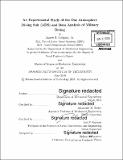| dc.contributor.advisor | Alexandra H. Techet and Joel P. Harbour. | en_US |
| dc.contributor.author | Colgary, James J., Jr | en_US |
| dc.contributor.other | Massachusetts Institute of Technology. Department of Mechanical Engineering. | en_US |
| dc.date.accessioned | 2016-09-13T19:23:12Z | |
| dc.date.available | 2016-09-13T19:23:12Z | |
| dc.date.copyright | 2016 | en_US |
| dc.date.issued | 2016 | en_US |
| dc.identifier.uri | http://hdl.handle.net/1721.1/104301 | |
| dc.description | Thesis: Nav. E., Massachusetts Institute of Technology, Department of Mechanical Engineering, 2016. | en_US |
| dc.description | Thesis: S.M., Massachusetts Institute of Technology, Department of Mechanical Engineering, 2016. | en_US |
| dc.description | Cataloged from PDF version of thesis. | en_US |
| dc.description | Includes bibliographical references (pages 93-94). | en_US |
| dc.description.abstract | The Atmospheric Diving Suit (ADS) is a one-man submarine with moveable, humanlike appendages with internal pressure maintained at one atmosphere. This precludes the possibility of common diving related illnesses while giving the operator an increased depth of operation compared to traditional diving systems. The ADS provides additional capability for industries and militaries around the world, but is not without its own unique challenges and limitations. Current ADS maneuverability, specifically that associated with joint rotation, lacks natural movement and range of motion, rendering most normal underwater tasks more challenging and taxing on the operator. Concerns about the lack of maneuverability and usability of the current ADS, primarily raised by the US Navy and ADS operators, prompted the Office of Naval Research (ONR) to fund an investigation into the next-generation ADS. In partnership under a Small Business Technology Transfer (STTR) contract, Mid6 Technology and MIT teamed up to investigate new joint design. To better understand the existing ADS and characterize the kinematics of elbow and shoulder rotation, an experimental test was completed with the commercial OceanWorks 1200 ft HARDSUITTM ADS at Phoenix International. Using a suite of Inertial Measurement Units (IMUs), equivalent ADS elbow and shoulder flexion/extension angles were extracted. A custom MATLAB® script was written to process data based on previous MIT IMU research associated with spacesuit design and other biomedical IMU research. The ADS pilot's movement inside the suit characterized the current suit's maneuverability, baselining capability. This study will inform future joint design by improving the understanding of the current ADS. In conjunction with the kinematic study, a numerical analysis of all military diving data was completed to better understand "how" the military dives. All military dive data is available to the public via www.militarydivingdata.com or http://divingresearch.scripts.mit.edu/militarydivingdata/ . | en_US |
| dc.description.statementofresponsibility | by James J. Colgary, Jr. | en_US |
| dc.format.extent | 94 pages | en_US |
| dc.language.iso | eng | en_US |
| dc.publisher | Massachusetts Institute of Technology | en_US |
| dc.rights | M.I.T. theses are protected by copyright. They may be viewed from this source for any purpose, but reproduction or distribution in any format is prohibited without written permission. See provided URL for inquiries about permission. | en_US |
| dc.rights.uri | http://dspace.mit.edu/handle/1721.1/7582 | en_US |
| dc.subject | Mechanical Engineering. | en_US |
| dc.title | An experimental study of the one Atmosphere Diving Suit (ADS) and data analysis of military diving | en_US |
| dc.type | Thesis | en_US |
| dc.description.degree | Nav. E. | en_US |
| dc.description.degree | S.M. | en_US |
| dc.contributor.department | Massachusetts Institute of Technology. Department of Mechanical Engineering | |
| dc.identifier.oclc | 958163769 | en_US |
